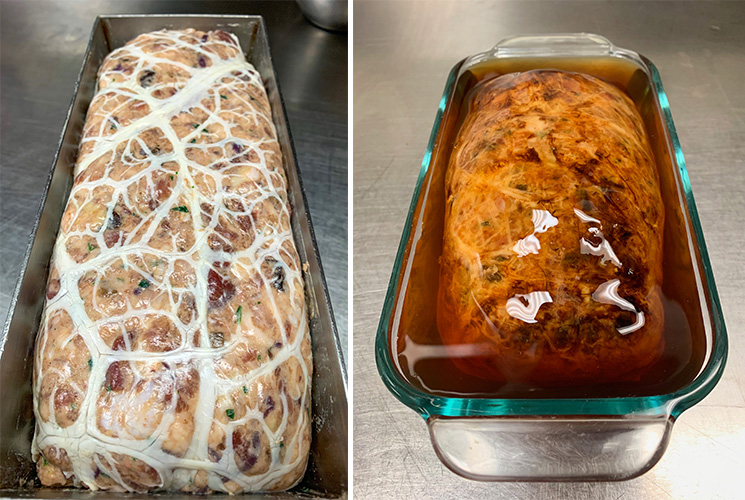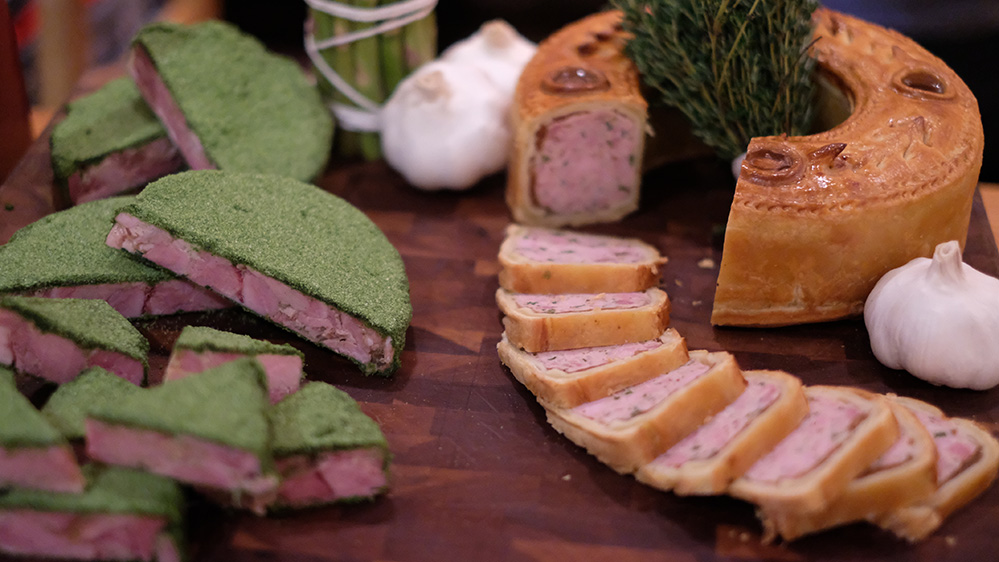Tucked away on a side street in the center of Manhattan is a bustling kitchen with more than 40 chefs working tirelessly. This is the hub of Daniel Boulud’s famed restaurant group, Dinex. The scent of freshly baked bread and pastries lingers in the air and careful production of bright macarons and croissants fills the halls. Within this operation, Chef Daniel Boulud has an army of dedicated expert chefs, each overseeing their department with an eagle eye.
I am here to spend the day working with one such master of trade, Arthur Dehaine, the chef charcutier for the restaurant group. Chef Arthur oversees the entire charcuterie department, from design to production.
From age 6, Arthur had his hands on charcuterie, helping his father make pâté and terrine and cooking with his mother in the rural countryside of Piccardy in Northeastern France. He grew up around livestock, and it was common in his community for neighbors, friends and family to enjoy a shared table of charcuterie.
Arthur continued his passion for food, studying kitchen and restaurant management at Ferrandi Paris. He moved on to intern at famed Le Chambard, a two Michelin-starred restaurant in Alsace, France. For his apprenticeship, he worked at Le Marloe, followed by L’Arome and Boutary.
Intrigued by the many facets of the industry, Arthur had a desire to explore something new in food. He began working for Gilles Verot, a world-renowned charcuterie expert and French culinary icon. At Maison Verot, Chef Arthur learned from France’s best charcutiers and began to hone his craft in this specialized art form.
“In France, we see charcuterie everywhere, but when it’s done to perfection with respect for ingredients and technique, it is quite amazing,” he says.
Arthur and I explore charcuterie and its part in the culinary world during my day in the kitchen, which stirs passion and debate. We discuss how charcuterie has changed over the last 50 years. As with many areas in the food industry, corporate domination stifled the development of the artisan. In France and indeed across Europe, supermarkets aim to offer everything under one roof. The local butcher, fishmonger, boulanger and charcutier have been put under enormous financial pressure. Trades in which expert knowledge would traditionally be passed on to the next familial generation were disappearing fast. This, coupled with the movement of young people from rural areas to metropolises, added to the decline of the artisanal charcutier.
Supermarkets, keen to appease the busy corporate worker, started to offer everything you could find at your local butcher shop or charcuterie in one shopping trip. Equally as keen to make a profit, quality was reduced and automated production was increased. All of a sudden, generations were growing up with this mass-produced, artificial version of this traditionally beautiful product. The same is true of pâté and sausage, rillettes and terrines, specialties lost to the modern needs of convenience and accessibility.

Arthur and I work on producing the Parisian ham, jambon de Paris, in his kitchen. We make it the traditional way, each ham individually seasoned, hand formed and rolled, cooked carefully under a watchful eye. This is a far cry from the industrially produced “jambon de Paris,” found thinly sliced and packed into a plastic container full of preservatives and added flavorings. There is good news however. Young chefs see an opportunity to reclaim the majestic nature of these all-but-forgotten art forms.
A revival in pastry over the last 15 years has shown that this can be transformed. Bread and pastries are on the ascendance in terms of quality, style and variety as young cooks and chefs are determined to reform this artisanal craft, respectfully reinventing their versions for the modern palette and the modern eye.
Arthur is one of a generation of young expert charcutiers, committed to the revival of an art that had recently been pushed aside. “My vision is that people will once again sit down at a café or restaurant and share charcuterie,” he says. “We can take the traditional methods of creating these products and add a freshness and a vibrancy through color, flavor and texture.”
Arthur and I test a new recipe, a take on the classic rillette. This version is made with chicken leg slowly cooked in pork stock, flavored with Kaffir lime, yellow, red and green peppers, chili peppers, ginger, and Thai basil. The beautiful combination of flavors is both fragrant and light. Arthur is spinning traditional charcuterie, adding a modern, deft touch. “We add kale and green peppercorn to our terrine for vibrancy, freshness, taste and color,” he says.

Another advantage to the new generation of producers is the advance in technology. Modern equipment can now be fully adjusted. The contemporary charcutier is able to customize temperatures for specific textures and times. Arthur can monitor the exact temperature of all of his products while heating and cooling. Vacuum sealers, smokers, steamers and ovens offer an unparalleled precision, which was not available to the previous generation of artisanal producers. “With modern cooking techniques, we are able to have full control,” he says.
Chef Arthur’s terrines are beautifully created, colorful and vibrant, aromatic, and light. I am in awe of his dedication to this work. At such a young age, Arthur is redefining the reputation of his craft. With his masterful hand, vision and dedication, he and a generation of young cooks and charcutiers are leading the way for the future of a once-diminishing tradition. They are changing common perceptions, opening eyes and reeducating palates.
The next time you see a crafted charcuterie product, be curious, be open-minded and you may be surprised.
Make your way to charcuterie day in our Culinary Arts program.




